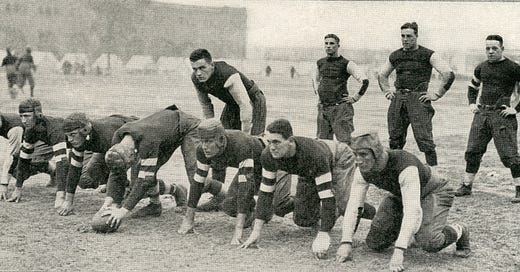August 14, 1918: Great Lakes Football Practice In Full Swing
This is the first of a series of articles over the next five months that will follow the 1918 Great Lakes and Mare Island teams on their way to the 1919 Rose Bowl.
As football practice begins every August, football coaches across the country wrestle with how to replace the players lost from last year’s roster. That was a bigger problem than usual for the coaches of the military training camp teams of WWI since most teams had few, if any, players left from their 1917 teams. Most of the 1917 players completed their initial training and were transferred elsewhere for further training or, more commonly, were in Europe engaged in or preparing for battle.
The Great Lakes Naval Training Station fielded an all-station football team in 1917 that lost its first two games to Marquette and Camp Custer, and then won five of their last six, including a victory over Iowa. As Great Lakes began preparing for the 1918 season, only four players of the 1917 team remained: Jimmy Conzelman of Washington University, Hugh Blacklock of Michigan State, Hal Erickson of St. Olaf, and Kent McCauley of Geneva College.

The 1918 team was coached by Herman P. “Bo” Olcott. Olcott was a football veteran having played for Yale in 1901 and 1902 before coaching at North Carolina and New York University. He was coaching at Kansas when Walter Camp, a fellow Yalie and the U.S. Navy’s Athletic Director, appointed him the football coach at Great Lakes. Olcott’s assistant coach was Lt C. J. McReavy, a 1914 Annapolis grad who was a three-year starter in football and basketball for Navy. McReavy was aboard the U. S. S. Potter when the war started and spent time with the ship patrolling European waters before being ordered to Great Lakes. McReavy’s day job at Great Lakes included responsibility for the officer material school (enlisted men training to become ensigns).
Olcott called his first practice for backs and ends only on August 8th and then added linemen to the practices over the next several days. Of the forty thousand sailors training at Great Lakes, over five hundred tried out for the station football team, likely the largest number of athletes trying out for a team to that time. A sizable portion of those trying out were college football veterans from the Midwest. Over the next several weeks, Olcott and McReavy put the team through conditioning and drill work before cutting the roster in September. Throughout this period, new recruits arrived in camp and joined the team, while others such George Halas, Paddy Driscoll, and Jerry Jones joined the team at the conclusion of their baseball season.

As the results of the season would show, the 1918 Great Lakes team had more talent than any military camp or college team in the country. It would take the better part of three weeks to cut the roster in half, several other cuts halved the roster again, until sixty remained and, of those, only a third traveled to Iowa for their first game at the end of September. By then, the Spanish Flu was roaring through the Great Lakes Naval Training Station with nearly ninety of the team’s fellow sailors dying each day.
Click here for options on how to support this site beyond a free subscription.



